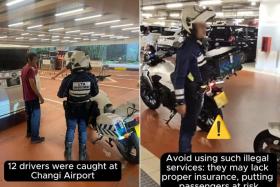Standardised insurance for ride-hailing drivers and delivery riders
All ride-hailing drivers and delivery riders who use apps will have a basic insurance cover for workplace injuries, regardless of the number of hours they have worked or how many platforms they are working for.
In a major step-up in the protection of about 73,200 people working on such platforms here, the Advisory Committee on Platform Workers on Wednesday fleshed out a new insurance and compensation scheme for the sector, adapted for the flexibility of the gig economy.
Changes will kick in by 2024, at the earliest.
The scheme’s stipulations bring it in line with insured amounts for employees in other sectors who are protected under the Work Injury Compensation Act (WICA), covering three areas: medical expenses caused by an accident; full income loss compensation for a time period after an accident; and a lump sum compensation for permanent disability or death.
This is a particularly welcome change by platform workers, given that they spend long time on roads and are particularly susceptible to accident or injury.
During the year-long consultation period with over 20,000 platform workers, only 36 per cent of respondents said they were happy with their current medical benefits.
Today, platform workers’ protections fall far short of WICA standards, in both scope and amount.
The committee found that although some platform companies voluntarily provide workers with compensation for work injuries, this is unevenly applied across different platforms.
For example, it is sometimes dependent on the number of hours a worker has worked.
Platform companies’ coverage for death or permanent disability is also largely in the $10,000 to $30,00 range, compared to employees’ entitlement under WICA of up to $289,000.
But beyond setting up a standard of coverage for platform workers, the committee said it also had to establish protocol for two issues unique to platform workers.
First, how to divide compensation for a worker if he or she works for multiple platform companies, as is the norm in the sector.
And second, given the flexibility of work, when a worker should be considered on a job and when not -- a definition which has implications on whether a worker can make injury claims.
After checking with insurers, the committee decided that the company which the platform worker is working for at the point of injury will have to compensate all the worker’s claims.
This means that a worker who gets into an accident while working for company A, but who also works for companies B and C, will make all his claims against company A.
The committee said that unless one platform company is particularly accident-prone, total compensation given by each company should average out, without reducing the total number of insured amount to the economy and to workers.
As for when a worker is considered at work, the committee said this will be the span of time from when a driver or food delivery rider accepts a job on the app to the drop-off of a passenger or food parcel, plus an indeterminate “x” amount of time.
It left the definition of “x” to the Government so that it can formulate an average figure for the time riders are spending waiting for orders, which should still count towards riders and drivers’ working time.
The committee said insurance for drivers and riders should be provided through the existing open and competitive insurance market and would not require strong market intervention by the Government.
Get The New Paper on your phone with the free TNP app. Download from the Apple App Store or Google Play Store now


